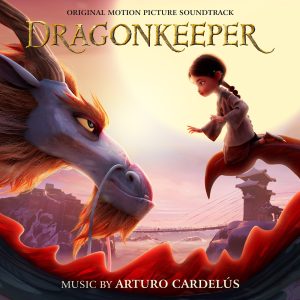
When I write reviews, I usually write about a soundtrack from a movie, TV show or game that has just been released. This review will be different, because I really want to talk about the music from Dragonkeeper, which is an animated film that was released a couple of months before writing this review.
Dragonkeeper is the result of a collaboration between Spain and China and has a Chinese and a Spanish director. The responsibility for composing the music was given to Spanish composer Arturo Cardelus, who has been active in the field for a decade but was an unfamiliar name to me. It was his job to enhance the world, in which Ping and Danzi, a small girl with magical powers and one of the last Chinese dragons, try to keep the last remaining dragon egg out of the hands of the evil scientist Diao. The Eastern and Western worlds are merged perfectly for this animation by writing a traditional orchestral score, with main melodies performed on traditional Chinese instruments like the erhu and the yangqin.
The music for this movie focuses heavily on three themes. The first theme is for Ping and contains a gracious melody for the little girl, but it is also accompanied by a strong counter-melody, as can be heard in the first track, “Her Name is Ping.” In addition, the theme also represents Dragonkeepers in general, which is the source of her powers. The theme returns in many places on the album, including a full orchestral version at the end of “In Ancient Times,” another emotional version on piano in “My Name Is Ping” and in “I Will Fight For You,” in which the counter-melody is more prominent at the start, before the main melody of the theme kicks in.
The second theme is for the dragon Danzi but it represents other dragons as well. The theme also has a gracious melody and can be heard prominently in “The Wind Will Carry Us,” as a fantastic build-up in “Danzi Fights Back” or at the start of “Dragon Attack!” It is a great theme to represent the dragon’s power but also its wisdom. What is also interesting is that this theme does not have a counter-melody like the Ping theme does but contains an A- and a B-section, which both can be found throughout the film. In addition, it also fits together with the Ping theme exceptionally well, as if they were a pair.
The last theme is for Diao and all the evil that surrounds him. His melody is ominous and low, as can be heard in “Master Diao” or “A Left‐handed Girl?” An interesting version of his theme can be heard in “Hello, My Friend,” telling the audience that things are not as they appear.
There are a couple of aspects to a theme in general that make them great. The first is that the melody must be easy to remember. Listening to the music on its own should help you tell the story without any context of the images. Another thing is that it should also reflect the element it represents perfectly well, which also helps in retelling the story. The last aspect, arguably the most important, is that the theme’s melody needs to be able to hold its ground in even its most intimate form. Many simple melodies sound epic when performed by a large orchestra, choir and additional artificial sounds, but they can also fall flat when the theme is performed by a single or a handful of instruments. Cardelus shows us that is not the case with the themes he has created for this film, because the versions performed by piano, flute and cello are still gorgeous listening experiences, as can be heard in “Danzi’s Theme – Trio Version” and “Ping’s Theme – Trio Version.”
Having only three themes makes it easier for children, who are the main target for this film, to understand what is happening on screen. This sounds simple, by just having the melody of a theme to be heard when the scene focuses on one of the characters, but the execution of it of doing it well and refreshing, makes it a challenge. When I listen to the music for Dragonkeeper independently, I can completely relive the story, and I am in awe of how brilliantly these themes blend together. None of the theme’s melodies sound the same and perfectly reflect the emotion needed on screen. The best example of the theme integration can be found in “The Great Battle,” which is a brilliant track, showcasing the fight between good and evil. I consider this track one of the best this year and will be a major contender for winning Best Music Composition of the Year for me. Many people outside of Spain or China have probably never heard of this film and will not watch it. That is a shame because the movie was quite fun to see in the context of being a family film. The music is astonishing as well, and I consider this one of the best scores that has come out this year.
Listen or buy
- Buy this soundtrack from Amazon, Apple Music or CDClick/Moviescore Media (CD on demand)
- Listen to this soundtrack on Spotify
Tracklist
The highlights are in bold.
- Her Name Is Ping (1:15)
- Master Diao (1:04)
- In Ancient Times (1:07)
- My Son, It’s Too Late (1:23)
- A New Day (2:22)
- Dragon’s Dungeon (1:43)
- My Name Is Ping (1:44)
- The Wind Will Carry Us (1:40)
- A Dragon’s Death (1:18)
- A Left‐handed Girl? (1:43)
- Danzi Is Transported (1:45)
- I Will Fight For You (1:08)
- Get That Girl! (1:40)
- Danzi Fights Back (2:20)
- The Bridge (2:30)
- The Long Road (1:38)
- Diao Arrives (1:26)
- Did You Pay Attention? (1:01)
- Dragon Attack! (2:16)
- Arrest Her! (1:34)
- I’m Not a Servant (1:01)
- Hello, My Friend (1:59)
- The Great Battle (6:07)
- Kai (1:22)
- I Am a Dragonkeeper (3:15)
- A New World (End Credits) (2:46)
- Danzi’s Theme – Trio Version (2:40)
- Ping’s Theme – Trio Version (2:25)
Total length: 54 minutes
Atresmúsica (2024)





Definitely my favourite soundtrack of the year. Thanks for the great write-up!
Greetings from Germany!